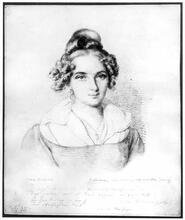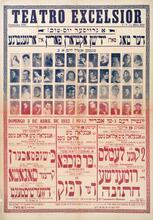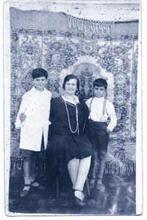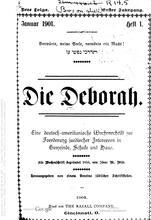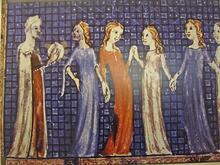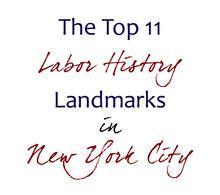Argentina: Jewish White Slavery
Between 1875 and 1936, Buenos Aires was a major prostitution hub. Economically desperate or restricted by inflexible Jewish marriage laws, Jewish women arriving to Argentina from Europe conceded to working in legally sanctioned brothels founded by Jewish pimps with capital. In 1910 the First Jewish International Conference on White Slavery released a report stating Buenos Aires had 42 legal brothels, 39 of which were owned by Jews. Although Jewish women made up just a third of legal prostitutes, they were disproportionately visible in a Catholic society, and moral reformers could easily obtain their nationality. In 1930, two Jewish women spoke out publicly about their experience of coercive prostitution. These revelations led to mass arresting of pimps and a ban on brothels in Buenos Aires in 1935.
Fear of Jewish white slavery, the sexual traffic in immigrant Jewish refugee women, often conducted by Jewish men, was a topic that preoccupied Jewish communities in Europe and immigrant communities in North and South America from the 1880s until the outbreak of World War II. Of all Latin American cities, Buenos Aires, Argentina, was cited as a haven for white slavers because it had a system of municipally regulated prostitution from 1875 until 1936, when a national law, the Law of Social Prophylaxis, outlawed brothels throughout Argentina.
Jewishness & Prostitution
Jewish women emigrated to Argentina from Poland, Russia and Germany in an attempt to escape poverty and religious persecution. Pressed into prostitution by inflexible religious laws such as those regarding agunot (anchored wives unable to obtain a divorce), the economic desperation of entire families, and the belief that wives, even those married under false pretenses to pimps, should obey their husband, they were among the groups of immigrant women most at risk in Buenos Aires.
As immigrants in a predominantly Catholic society, the Jewish community in Argentina—the largest in South America—became very concerned about reports of Jewish criminality in any form. The claims of white slavery, Jewish pimps, and Jewish prostitutes shook the community to its very core, and every attempt was made to separate the Jewish criminal element from the larger community, including banning them from synagogues in Buenos Aires. In 1908 the Jewish community held a public meeting to discuss the implications of street protests in Jewish neighborhoods against pimps and their relatives. Among the people invited to attend was the first Socialist elected to the national legislature, Alfredo Palacios (1880–1965), who in 1913 drafted legislation to deport foreign pimps, and Manuel Gálvez (1882–1962), a Catholic conservative who had recently written a thesis on the white slave trade. According to Gálvez’s memoirs, pimps paid the crowd to disrupt the meeting with insults in Yiddish and by throwing objects at the committee organized to discuss the subject (Gálvez, 1905 and 1961).
In 1913, Samuel Cohen, Secretary of the London-based Jewish Association for the Protection of Girls and Women, went to South America to ascertain the plight of Jewish women and their victimization. Although he also visited Rio de Janeiro, São Paulo, and Santos (all Brazilian cities), as well as Montevideo, Uruguay, he devoted most of his journey and comments to Buenos Aires. Wherever he stopped in South America there were Jewish women in brothels, many of whom spoke Yiddish, and most of whom were Russian or Polish (Cohen 1913, 1–10).
In Buenos Aires he learned that no anti-white slavery groups were allowed to board vessels to help women arriving from Europe seek work. He did note that an Argentine Anti-White Slavery society had already been established and that the local Immigrant Hotel did its best to find both men and women decent employment. According to the people he interviewed, the moral conditions in Buenos Aires had improved considerably from earlier years. “Immorality is still bad, but it is not so flagrant, nor is it so much countenanced as it was formerly.” Indeed many Argentines had come to support European views that female white slavery should not be tolerated, and anti-white slavery laws had been passed. Nevertheless, Cohen blamed the existence of legal houses of prostitution in the capital for the continued problem of immorality. As he put it, “I have talked to the ‘Madames,’ and the only conclusion that I can come to is that they [the brothels] are dens of iniquity, and ought to be closed as quickly as possible” (Cohen, 14–16).
While over thirty-five thousand Jewish emigrants had arrived since 1908, according to the calculations of the Jewish community, more Jews had arrived earlier and continued to pour into Buenos Aires. Among the few people Cohen found interested in the problem of Jewish white slaves was Rabbi Samuel Halphon of the Libertad Street synagogue, and Madame Francesca de Krämer of the Sociedad de Beneficencia de Damas Israelitas, who expanded their work with poor Jewish women to help women in danger of becoming prostitutes (Cohen, 27–29).
As part of his visit to Buenos Aires, Cohen went to brothels operated by Jewish women (Cohen, 30).
It is with shame that I have to say that many Jewish women, themselves mothers of families, are amongst those who are running the houses. They were not pleased with my visit. They did not like the questions that I asked them or the arguments that I put forward against the continuation of their ‘trade.’
…. They were ashamed, too, that a Jew was taking up the enquiry against them.
Investigations, Studies, & Reports
Samuel Cohen was not the first observer to criticize the plight of Jewish women who engaged in prostitution in late nineteenth and early twentieth century Argentina. Almost as soon as the municipality of Buenos Aires passed an 1875 ordinance regulating brothels as part of a public health campaign to prevent venereal diseases, reports of Jewish white slavery were published in European and Argentine newspapers. In March 1875 the local paper La Nación reported that a French court had condemned a man and woman to jail terms for trafficking in women, and soon reports of Jewish prostitution as well as Jewish pimps emerged (Bristow 1982, 113). In March 1907, two Russian Jews, Louis Gold and Harry Cohen, were “charged with procuring Jane Goldbloom and another young woman to lead an immoral life” in London because Gold had received word from Buenos Aires that attractive young girls were worth £100. This was one of several cases discovered by British police (Vigilance Record).
In 1910, the First Jewish International Conference on White Slavery released another report. It stated that in 1903 Buenos Aires “had forty-two known houses of which thirty-nine were owned by Russian Jews. …Of eight hundred new prostitutes registering in 1909, 236 were Jewish, of whom 213 were Russian” (Kaplan 1979, 111).
How did all these observers identify the Jewish prostitutes when there were no statistics of religious beliefs? When women registered to enter licensed houses of prostitution, they were asked about their nationality, among other things. Those women who identified themselves as Russian, Polish, or German, were assumed to be Jewish not only by the Jewish community, but also by representatives of those countries. The women found work in brothels through the efforts of Jewish pimps who began to organize in the late nineteenth century and had enough capital to set up the houses of prostitution and pay for a Madame to operate them. The existence of organizations such as the El Club de los 40, Varsovia, Asquenasum and later the Zwi Migdal, coupled with the ease with which moral reformers could obtain nationality statistics for legal prostitutes, made Jewish prostitution very visible, even though the much larger community of clandestine prostitutes were of Spanish, Italian and Argentine nationality.
The traffic in Jewish white slavery continued until the outbreak of World War I, and resurged after World War I. In the 1920s the investigations of the League of Nations, particularly its 1927 Report of the Special Body of Experts on Traffic in Women and Children, once again highlighted the visibility of Jewish prostitutes and traffickers. The following year one of the journalists involved in the League of Nations investigation, Albert Londres (1884–1932), published a study entitled Le Chemin au Buenos Ayres (The Road to Buenos Ayres). One of the English versions had a dust jacket with a provocative picture of two white women chained to each other. This chauvinistic and anti-Semitic book described French pimps in Buenos Aires as patriots who saved women from a life of lesbianism and cocaine, but had only negative comments about the Jewish pimps (League of Nations, 1927; Londres 1928).
End of Legal Prostitution
The plight of two Jewish women caught up in white slavery led to the final political campaign to ban municipally regulated houses of prostitution in Buenos Aires. In 1930 Cosía Zeilón described how she had been forced by the famous Jewish madame Emma “The Millionaire “and the pimp Luis Migdal to engage in prostitution. That same year, Raquel Liberman accused the Zwi Migdal organization and her husband of forcing her back into prostitution years after she had used her savings to open an antique store. These revelations led to massive arrests of pimps who belonged to the Zwi Migdal, as well as a new decree to ban brothels in Buenos Aires after December 31, 1934. In December 1936 a national Law of Social Prophylaxis prohibited all municipalities from operating brothels and mandated prenuptial medical examinations for all men. While prostitution was not a crime, hereafter the police determined when prostitutes would be arrested.
World War II did more to end the traffic in Jewish prostitutes in Argentina than any local legislation. Women who escaped to Argentina and later from prostitution married into the Jewish community and subsequently led normal lives.
Alsogaray, Julio. Trilogía de la trata de blancas: Rufianes—policía—municipalidad. Buenos Aires: N.p., 1933.
Avni, Hiam. Argentina y la historia de la inmigración judía 1810–1950. Jerusalem: Magnes, 1983.
Bra, Gerardo. La organización negra: La incredible historia de la Zwi Migdal. Buenos Aires: N.p., 1982.
Bristow, Edward. Prostitution and Prejudice: The Jewish Fight Against White Slavery, 1870–1939. New York: Schocken Books, 1982.
Cohen, Samuel. Report of the Secretary on His Visit to South America, 1913. Oxford: N.p., 1913.
Galvez, Manuel. La trata de blancas: Tesis para optar al grado de doctor en jurisprudencia. Buenos Aires: N.p., 1905.
Galvez, Manuel. Recuerdos de la vida literaria, 4 vols. Buenos Aires: Hachette, 1961.
Glickman, Nora. The Jewish White Slave Trade and the Untold Story of Raquel Liberman. New York: Garland, 2000.
Guy, Donna J. Sex and Danger in Buenos Aires: Prostitution, Family, and Nation in Argentina. Lincoln, NE: University of Nebraska Press, 1991.
Jewish Association for the Protection of Girls and Women, Annual Reports. Oxford: 1904–1932.
Kaplan, Marion A. The Jewish Feminist Movement in Germany: The Campaigns of the Jüdischer Frauenbund 1904–1938. Westport, CT: Greenwood Press, 1979.
Londres, Albert. The Road to Buenos Ayres. Translated by Eric Sutton. London: Constable, 1928.
Mirelman, Victor. Jewish Buenos Aires, 1890–1930: In Search of an Identity. Detroit: Wayne State University Press, 1990.
Official Report of the Jewish International Conference on the Suppression of the Traffic in Girls and Women: Private and Confidential. London: Central Bureau, Jewish Association for the Protection of Girls and Women, 1910
Report of the Special Body of Experts on Traffic in Women and Children, 2 parts. Geneva: League of Nations, 1927.
Vigilance Record 3 (March 1907) London: 23.
Yarfitz, Mir. Impure Migration: Jews and Sex Work in Golden Age Argentina. New Brunswick: Rutgers University Press, 2019

